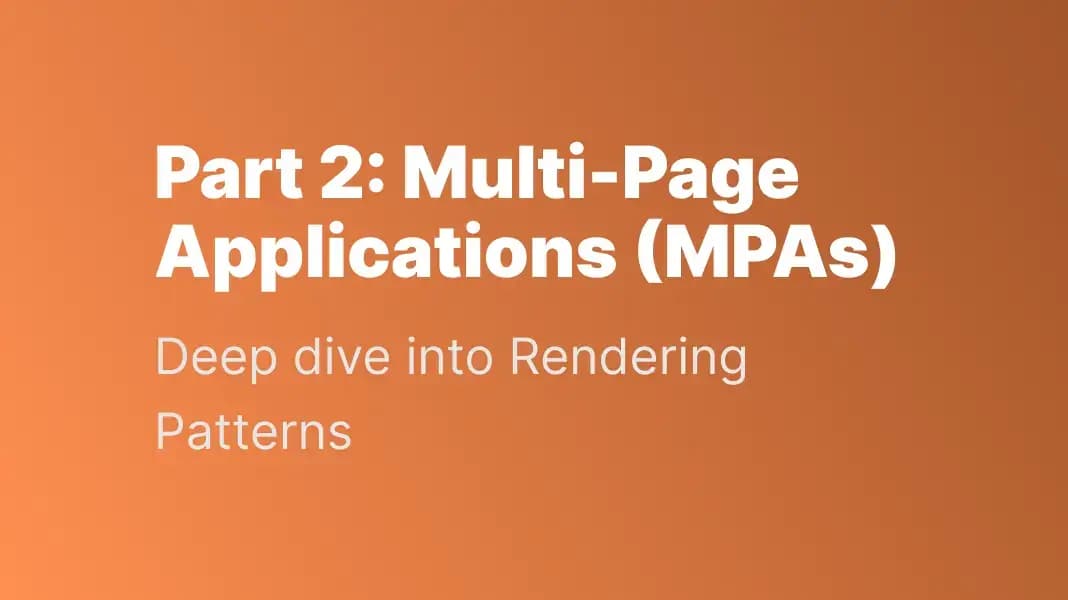user
Hey Chat, could you explain Multi-Page Applications (MPAs) in simple terms, assuming I have no idea about rendering patterns? 🤔

Hamza Miloud amar
June 5, 2024
4 min read

Welcome back! Last time, we discussed Static Sites. Today, we'll look into Multi-Page Applications (MPAs), which involve multiple web pages, each reloading entirely when navigated. MPAs are traditional but still widely used in many web applications for their simplicity and straightforward navigation.
Web Development Group
Me , Server , Browser, CDN, Narrator
user
Hey Chat, could you explain Multi-Page Applications (MPAs) in simple terms, assuming I have no idea about rendering patterns? 🤔
narrator
Think of an MPA website like a build your own sandwich at a food truck. 🥪 You've got all sorts of options – different breads, meats, cheeses, veggies, and sauces. You pick what you want, and the chef puts it together for you right there.
user
Mmm, that sounds interesting! Could you explain a real world example, showing the step by step process of how the server and browser work together to make this happen? 🤔
server
Great question! In an MPA, I'm the server. Each page request triggers a sequence of actions: I first get the page requested, then execute any necessary server-side tasks, such as fetching data, processing images, or executing other logic. Once these tasks are complete (or if none are required), I dynamically generate the HTML and deliver it to your browser for rendering.
browser
And I, the browser, take the freshly assembled files (HTML, CSS, JS) and render them into the webpage you see.
user
That makes sense! So, when should I use an MPA over other types of rendering Pattern? 🤷♀️
server
server
server
You need to personalize content based on user preferences or user data. 🔒
user
What are the main advantages of using an MPA? 👍
server
SEO Benefits: MPA ensures search engines can easily index your content. 📈
server
Improved Performance: Initial load times are generally faster with a fully rendered HTML document. ⚡
server
Enhanced Security: Sensitive data can be handled more securely on the server. 🔒
server
Better User Experience: Users get a fully-loaded page quickly, improving their experience. 😊
user
Are there any downsides to MPAs? 👎
browser
Yes, there are a few:
browser
Full Page Reloads: Navigating between pages requires reloading the entire page. 🔄
browser
Increased Server Load: MPA can place a significant load on the server. 🖥️
browser
Development Complexity: MPAs can be more complex to develop and maintain. 🤯
browser
Scalability Challenges: Scaling MPA-based applications can be demanding. 📈
user
I'm quite impressed with the concept of Multi-Page Applications (MPAs). However, I'm interested in understanding potential performance bottlenecks that could arise in an MPA architecture.
server
That's an excellent question. While MPAs offer numerous advantages, it's important to be aware of a couple of key performance considerations:
server
Resource Duplication:Shared resources like CSS and JavaScript files are often re-downloaded on each page load
user
I see. Could you outline strategies for mitigating these potential performance challenges?
server
Certainly! There are several effective approaches to optimizing MPA performance
server
user
What frameworks can I use to build an MPA? 🛠️
server
You have several options:
user
Thanks, Chat! This was really insightful. Any final thoughts? 😊
server
You're welcome! Multi-Page Applications offer a robust way to build dynamic, SEO-friendly web applications with fast initial load times and secure data handling. While they have their challenges, the benefits often outweigh the complexities.
browser
Stay tuned for our next conversation where we'll explore Client-Side Rendering (CSR) and understand how it differs from MPA, along with its advantages and disadvantages. 😉
user
Looking forward to it! 📚
me
Thanks for taking the time to read my article! I'd love to hear your feedback – any questions, suggestions, or different perspectives are welcome. Your input helps me improve and create even better content. Feel free to follow me and continue the conversation on 𝕏 to continue the discussion.
Thanks for exploring Multi-Page Applications with us. In our next post, we'll discuss Client-Side Rendering, a technique that offers a more interactive user experience. Goodbye, and see you next time as we dive into Client-Side Rendering!
Experienced Frontend Developer | Passionate about building elegant, accessible, and UX-friendly Design Systems with React | Skilled in React Next Remix | CSS enthusiast | Lover of Clean & Maintainable CSS | Always learning and growing.
Let's ConnectConnect With Me On Social Media
I appreciate your visit to my website. If you find my work interesting and would like to know more about me, please consider following me on social media. Thank you!
© 2025 Hamza Miloud Amar. All Rights Reserved
1253 Views